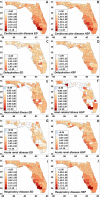Heat illness data strengthens vulnerability maps
- PMID: 34732187
- PMCID: PMC8567677
- DOI: 10.1186/s12889-021-12097-6
Heat illness data strengthens vulnerability maps
Abstract
Background: Previous extreme heat and human health studies have investigated associations either over time (e.g. case-crossover or time series analysis) or across geographic areas (e.g. spatial models), which may limit the study scope and regional variation. Our study combines a case-crossover design and spatial analysis to identify: 1) the most vulnerable counties to extreme heat; and 2) demographic and socioeconomic variables that are most strongly and consistently related to heat-sensitive health outcomes (cardiovascular disease, dehydration, heat-related illness, acute renal disease, and respiratory disease) across 67 counties in the state of Florida, U. S over 2008-2012.
Methods: We first used a case-crossover design to examine the effects of air temperature on daily counts of health outcomes. We employed a time-stratified design with a 28-day comparison window. Referent periods were extracted from ±7, ±14, or ± 21 days to address seasonality. The results are expressed as odds ratios, or the change in the likelihood of each health outcome for a unit change in heat exposure. We then spatially examined the case-crossover extreme heat and health odds ratios and county level demographic and socioeconomic variables with multiple linear regression or spatial lag models.
Results: Results indicated that southwest Florida has the highest risks of cardiovascular disease, dehydration, acute renal disease, and respiratory disease. Results also suggested demographic and socioeconomic variables were significantly associated with the magnitude of heat-related health risk. The counties with larger populations working in farming, fishing, mining, forestry, construction, and extraction tended to have higher risks of dehydration and acute renal disease, whereas counties with larger populations working in installation, maintenance, and repair workers tended to have lower risks of cardiovascular, dehydration, acute renal disease, and respiratory disease. Finally, our results showed that high income counties consistently have lower health risks of dehydration, heat-related illness, acute renal disease, and respiratory disease.
Conclusions: Our study identified different relationships with demographic/socioeconomic variables for each heat-sensitive health outcome. Results should be incorporated into vulnerability or risk indices for each health outcome.
Keywords: Case-crossover analysis; Heat vulnerability; Social determinants of health; Spatial lag model.
© 2021. The Author(s).
Conflict of interest statement
We have no competing interests.
Figures
References
-
- IPCC . Climate Change 2014: Synthesis Report. Contribution of Working Groups I, II and III to the Fifth Assessment Report of the Intergovernmental Panel on Climate Change. Geneva, Switz: IPCC; 2014. p. 151.
-
- Habeeb D, Vargo J, Stone B. Rising heat wave trends in large US cities. Nat Hazards. 2015;76(3):1651–1665. doi: 10.1007/s11069-014-1563-z. - DOI
-
- Beniston M, Stephenson DB, Christensen OB, Ferro CAT, Frei C, Goyette S, Halsnaes K, Holt T, Jylhä K, Koffi B, Palutikof J, Schöll R, Semmler T, Woth K. Future extreme events in European climate: an exploration of regional climate model projections. Clim Chang. 2007;81(S1):71–95. doi: 10.1007/s10584-006-9226-z. - DOI
Publication types
MeSH terms
Grants and funding
LinkOut - more resources
Full Text Sources
Medical


